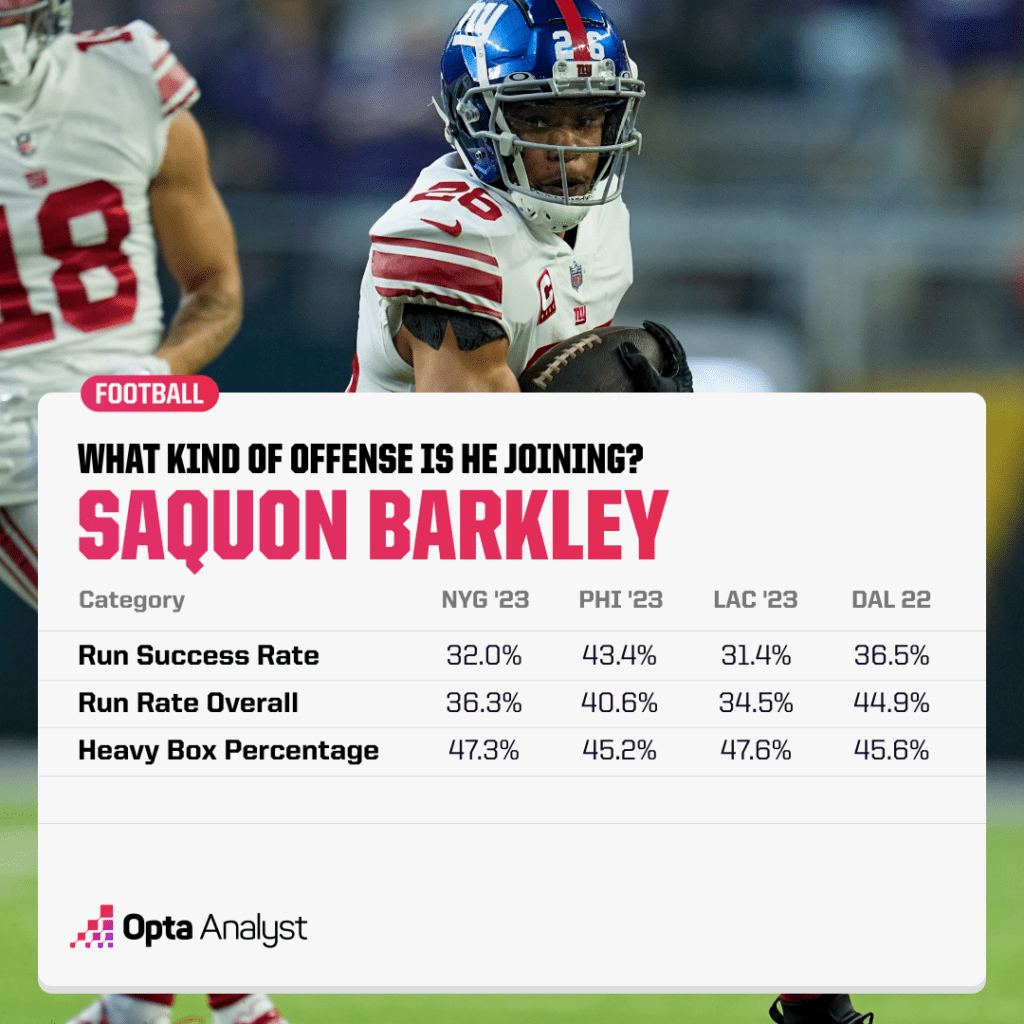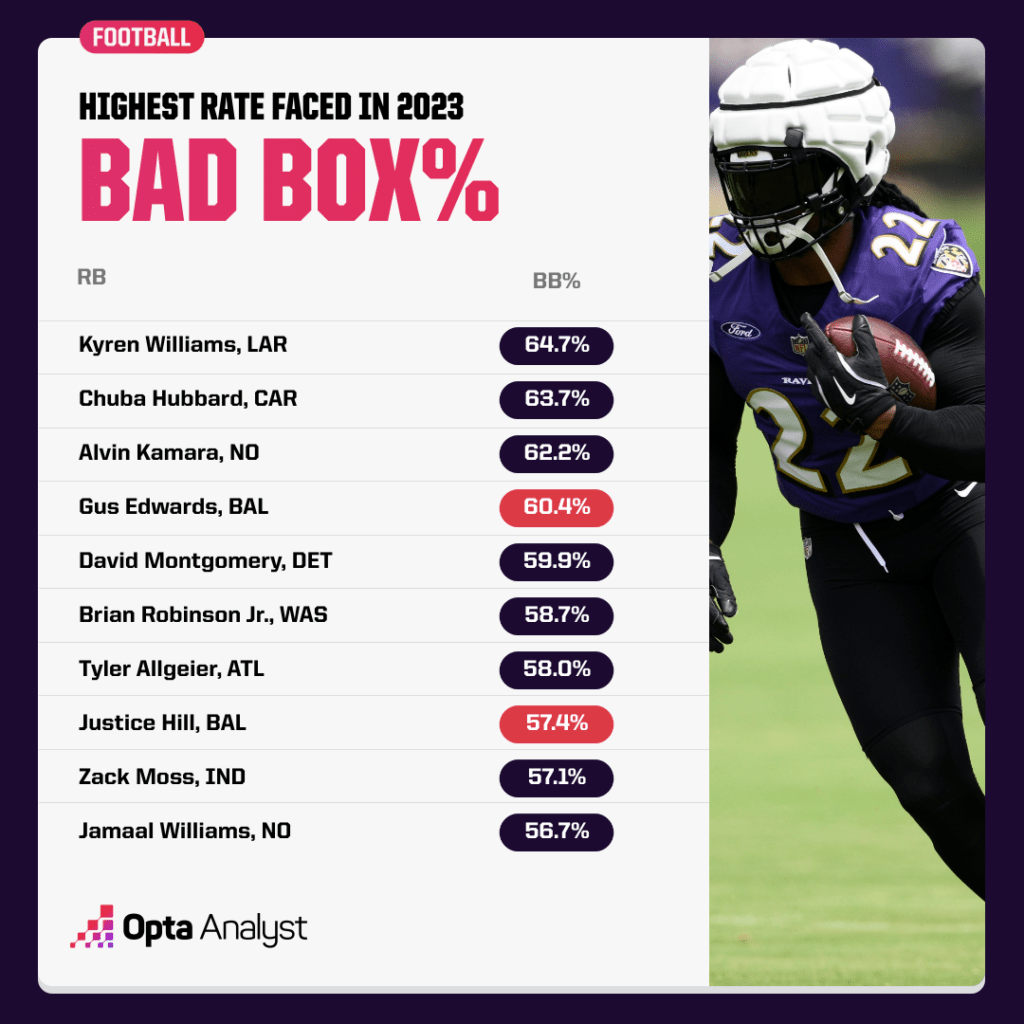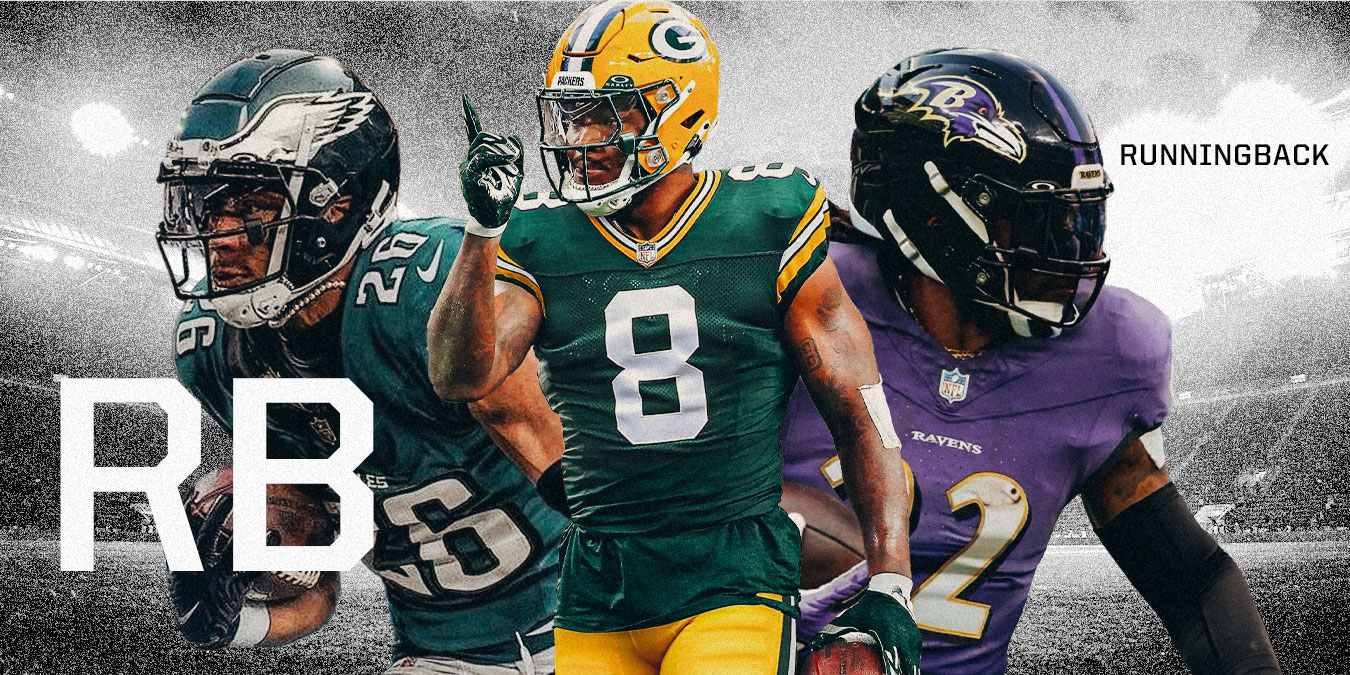Who should be the most happy with a move to a new backfield? We’re trying to answer that question by looking at which NFL running backs joined a team with a more successful running game and an offense that features backs more.
The running back landscape will look a lot different in 2024.
Not because there will be a new crop of rushers in the league, but because some of the top players at the position joined new teams at an unprecedented rate and will shake up the ground game in the NFL this season.
A total of 13 starting-caliber running backs either signed with or were traded to a different team this offseason, led by one-time rushing or scrimmage-yard leaders Saquon Barkley, Derrick Henry and Josh Jacobs. Before 2024, only 16 total running backs with at least 100 touches switched teams between 2021-23.
While it’s unclear exactly why or how this unfolded — our best guesses are age, strategic shifts or a disagreement on the running back market — many teams will be affected by the movement at this position. The players themselves will certainly see something happen to their production as well — for better or worse.
Historically, running backs rarely see immediate success on a new team. In the past three seasons, running backs on new teams averaged just 658.4 yards and 4.6 touchdowns (among 18 who rushed for more than 100 times). Only six rushed for more than 800 yards and just two (D’Andre Swift and David Montgomery in 2023) eclipsed 1,000 yards.
Now, this could be less about their situations and more about their usage (only nine rushed more than 150 times in their first season and just six did it more than 200) but the point still stands.
For this exercise, we’ll take a look at nine of the 13 starting-caliber running backs and see if they landed in a better or worse situation than the one they had on their previous team. We compared two baseline statistics from each running back’s old team with its new one: run success percentage and run rate.
Run success rate being how often a team gains a successful play (50% of the yards to gain on first down, 70% on second down, or 100% on third or fourth down) on a designed run play and run rate being how often it rushes the football overall.
Essentially, we’re looking at whether or not a running back joined a team with either a more or less successful running game and an offense that either features running backs more or less.
So a “better” situation is more about whether or not they’ll be put in a position to succeed based on how the offense is run. We also took into account whether or not a player would slide into an RB1 role or committee and if the new team has a rookie quarterback or not.
Here are nine of those players. The ones in a better, worse and too-soon-know spot.
Better Spot
Saquon Barkley, Philadelphia Eagles
Barkley earned the most obvious upgrade this offseason when he made the intra-divisional move from the New York Giants to the Philadelphia Eagles. Not only do the Eagles provide Barkley with an 11.3% better run success (based on their 2023 offense), but the team’s offense was also 4.3% more run-focused than the Giants’ this past season.
Now, there are some obvious caveats here. Firstly, Kellen Moore is now the offensive coordinator in Philadelphia. The other is the loss of center Jason Kelce, who anchored the Eagles’ impressive offensive line for 13 years before he retired after the 2023 season.
It’s unclear how much of a role Moore will have in play-calling duties or how much his offense will trickle down from head coach Nick Sirianni. But Moore’s presence could impact the running game given the previous offenses he ran with the Los Angeles Chargers in 2023 and Dallas Cowboys in 2022.
Moore’s offense in Los Angeles was a disaster — especially on the ground. The Chargers’ run success was worse than the Giants in 2023 (31.4% for L.A. vs. 32.0% for New York). The run rate was also slightly less, especially given Justin Herbert’s acumen under center and Austin Ekler’s declining efficiency.
Moore’s 2022 offense in Dallas was better from an efficiency standpoint (a plus-4.5% difference compared with the 2023 Giants) despite running the ball just as much as New York did a year ago.

This means that Moore’s effect on the offense might be even more beneficial to Barkley given how successful the Cowboys running game was for so many years.
Kelce’s absence might also be a mitigating factor given his replacement played alongside him in Philadelphia for the past two years. Cam Jurgens, who the Eagles drafted in the second round two years ago, started 31 games and played in 2,066 snaps at center in college at Nebraska. While he doesn’t have much NFL experience at the position, he certainly isn’t new to the role.
All this points to Barkley remaining one of the best running backs in the league. And this time, he’ll play for a squad with Super Bowl aspirations.
Derrick Henry, Baltimore Ravens
Henry left a Tennessee Titans team that tallied the second-most rushing attempts in the NFL since 2017 — the year he took over as the starting running back. Tennessee rushed 3,347 times, during which Henry led the NFL in carries four times, rushing yards twice and rushing touchdowns twice.
Coincidentally, Henry joined the only team with more rushing attempts and yards since the Titans during that span: the Ravens.
This bodes well for Henry’s 2024 campaign. Despite his age — Henry is the second-oldest running back in the league expected to start this year and the first if Raheem Mostert doesn’t start for the Dolphins — he will likely see the majority of snaps for a Baltimore team that has been historically good running the ball. The Ravens have never ranked lower than seventh in rushing attempts and 11th in yards since 2017.
Todd Monken’s first year as offensive coordinator bore impressive fruit from the ground game as well. The Ravens ranked first in attempts and yards this past season and fourth in rushing touchdowns. Baltimore also has a +5% difference in run percentage and a +1.5% run success rate difference compared to Tennessee.
Oddly enough, though, the rest of the Ravens’ offensive talent might actually be a detriment to Henry.
For one, Lamar Jackson’s rushing ability could potentially put Henry in worse rushing situations because of the team’s desire to keep a spy linebacker in case Jackson scrambles. In 2023, the Ravens faced the fifth-most heavy boxes in the NFL and their top two running backs — Gus Edwards and Justice Hill — ranked in the top eighth in bad boxes seen. Edwards ranked fourth at 61%, while Hill ranked eighth at 57.9% among running backs with at least 80 carries. Henry ranked 12th at 55.7%.

Some of that can be attributed to the threat of Jackson on the ground and the Ravens’ overall proclivity for establishing a rushing game earlier. However, the lack of a potent outside pass catcher has also contributed to the defenses’ continued box-stacking strategy.
The Ravens pass catchers weren’t great this past season, as Zay Flowers was the only one with more than 45 receptions and 550 receiving yards. Baltimore didn’t make any notable receiver additions, either, apart from DeVontez Walker in the fourth round and Deonte Hardy in free agency.
None of this should deter Henry from dominating from the ground. He’s still in an overall better spot than he was in Tennessee and should be able to continue to build on his impressive legacy.
Josh Jacobs, Green Bay Packers
Jacobs is likely in line for the same bellcow role he had with the Raiders, but with a young and ascending Packers team that has a great coach and quarterback combination in Matt LaFleur and Jordan Love.
Jacobs joins an offense that also had a much better run success rate than his previous squad. The Packers’ 36.0% run success rate is 2.4% better than the Raiders despite an identical run rate overall. Both Green Bay and Las Vegas ranked 17th with a 38.5% run percentage.
The Packers have a better overall offense as well — which is a good thing for any running back because it opens up pathways in the middle of the defense. This past year, the Packers’ top two rushers in Aaron Jones and AJ Dillon rarely ran up against heavy boxes. Jones ranked 27th and Dillon ranked 20th. Jones’ 4.6 yards per carry ranked 17th.
What’s odd, though, is that defenses rarely stacked boxes against Jacobs and the Raiders in 2023. Jacobs saw fewer bad boxes (player specific rather than the team-focused heavy box) than either Packers running back and ranked 32nd among all running backs. The Raiders as a team ranked 29th in heavy boxes faced — 3.9% less than the Packers, who ranked 18th at 47.6%.
The Raiders had a potent outside threat in receiver Davante Adams, which likely forced defenses to shift focus to the passing game rather than worry about the running game.
Now, Jacobs gets a better offensive coach with a better quarterback and offensive line in front of him. All of that should lead to a better situation for Jacobs in 2024.
Too Soon to Know
Joe Mixon, Houston Texans
The Texans were one of the worst rushing offenses in the NFL this past season. Second-year head coach DeMeco Ryans hopes Mixon and a healthy offensive line can change that.
The threat through the air with quarterback C.J. Stroud and the trio of wide receivers in Stefon Diggs, Nico Collins and Tank Dell should help Mixon’s cause in 2024. He enjoyed his best season in Cincinnati in 2021 when Joe Burrow threw for 4,611 yards and 34 touchdowns with two 1,000-yard receivers in Ja’Marr Chase and Tee Higgins coupled with 800-yard receiver Tyler Boyd. Mixon tallied 1,519 scrimmage yards and 16 touchdowns that season.
Houston offers a bit of a different identity, though. The team had a slightly worse success rate in 2023 than the Bengals by 2.8% and ranked 29th in yards per carry despite rushing 6.1% more. The Texans also ranked dead-center in heavy boxes faced.
With another year of Stroud and offensive coordinator Bobby Slowik as well as Tytus Howard and Kenyon Green back on the line, Mixon could be in a better overall position than he would have otherwise been in Cincinnati.
But that will depend on how Slowik incorporates Mixon into the offense compared to what he did with Dameon Pierce and Devin Singletary a year ago.
Aaron Jones, Minnesota Vikings
It’s hard to know how much worse Jones’ spot is for a few reasons. We don’t know how Kevin O’Connell’s offense will look without Kirk Cousins under center, and we also don’t know who will replace Cousins between Sam Darnold and rookie J.J. McCarthy.
Therefore, it’s unclear how much of the rushing stats from 2023 will play into 2024. Jones is objectively better than Alexander Mattison was and Ty Chandler is, but he’s certainly not on a better team than the one he left in Green Bay.
In this situation, though, the numbers aren’t in his favor. The Vikings had a slightly worse run success rate (0.4%) than the Packers and also ran the ball almost 6% less this past season.
While the Vikings encountered the second-fewest heavy boxes (39.4%) in 2023, that was when Cousins was under center for most of the season. O’Connell may shift more to the run if Darnold or McCarthy start.
Justin Jefferson is the only other reliable offensive weapon in Minnesota with T.J. Hockenson recovering from a late-season ACL tear and Jordan Addison potentially dealing with a suspension from a DUI. While this could mean more opportunities for Jones, it might also mean more focus from the defense.
Chandler is a looming presence as well, as his 4.52 yards per carry ranked 22nd among running backs this past season and he averaged 4.87 yards per carry in the final four games of the year with four combined touchdowns.
Jones is no stranger to backfield competition in Green Bay with Dillon recently and Jamaal Williams in the past, but he might not be in a much different situation than the one he left — just with a worse quarterback situation.
Austin Ekeler, Washington Commanders
Ekeler has a lot going against him in 2024: He’s the fourth-oldest running back in the NFL expected to see significant snaps, will likely be in a timeshare with a younger Brian Robinson and is on a new team with a new head coach, offensive coordinator and rookie quarterback.
There are a few positives here, though. The Commanders had an above-average run success rate in 2023 at 37.1% (almost 6% better than the Chargers) and made a significant upgrade to the offensive line with center Tyler Biadasz, who finished with more than double the run block wins than the Commanders’ centers in 2023.
But everything will depend on No. 2 overall pick Jayden Daniels, how new OC Kliff Kingsbury runs his offense (the 2022 Arizona Cardinals had almost the same run percentage as the 2023 Chargers) and what what role Ekeler plays behind Robinson — either as a third-down pass-catching running back or a true 50-50 split.
Ekeler’s production took a significant dip in 2023, when he averaged less than 4.0 yards per carry for the first time in his career. A change of scenery could reinvigorate him or just accelerate his decline in the backfield.
Worse Spot
D’Andre Swift, Chicago Bears
Swift’s move will be fascinating because not only did he switch teams, but he will play for a different offensive coordinator for the fifth consecutive year he’s been in the NFL.
That offensive coordinator, Shane Waldron, also deployed a running game that ranked 28th in run percentage and 31st in rushing attempts for the Seattle Seahawks in 2023. Now, Waldron’s with the Bears.
Compared to Swift’s 2023 team, Philadelphia, Waldron’s offense ran the ball 5.8% less and had a 6.8% worse success rate on the ground. It remains to be seen how much of that game planning will translate to Chicago in 2024. Oddly enough, the Bears were the fifth-most run-heavy squad in the NFL a year ago with Luke Getsy on the call.
Waldron isn’t the only new addition to the Bears alongside Swift. Chicago brought in two new receivers in Keenan Allen and first-round rookie Rome Odunze as well as No. 1 overall pick quarterback Caleb Williams.
All of that talent could be good for Swift, who finished 13th in yards per carry a year ago, but he could also become an afterthought on an offense that will look to get its rookie passer going early and often.
Tony Pollard, Tennessee Titans
A new shade of blue could be good for Pollard, though he won’t inherit Henry’s workload in Tennessee. The offense will be different with ex-Bengals offensive coordinator Brian Callahan at the helm and the emergence of young running back Tyjae Spears might stifle Pollard’s opportunity share.
Comparatively, Callahan’s offense with Mixon in the backfield for the Bengals rushed 4.8% fewer times than the Cowboys did in 2023 with Pollard. The run success rate was also 2.1% worse in Cincinnati than in Dallas as well.
Tennessee’s offensive line is also a work in progress with two first-rounders in 2023 pick Peter Skoronski and 2024 pick JC Latham. It remains to be seen if Will Levis can be an effective starting quarterback, even with a duo of solid pass catchers in DeAndre Hopkins and Calvin Ridley at his disposal.
None of those are particularly good signs for Pollard to regain his pre-injury form when he averaged 5.3 yards per carry from 2021 to 2022.
Zach Moss, Cincinnati Bengals
The only thing better about Moss being in Cincinnati rather than in Indianapolis is his potential role. He would have never been a starter with the Colts because of Jonathan Taylor. Now, Moss gets a chance to take on a bigger slice of the rushing game with Chase Brown as the only real threat in the backfield.
However, Moss joins an offense that will lean on its passing attack, especially with the promotion of quarterbacks coach Dan Pitcher to offensive coordinator.
The Bengals ran the ball 7.8% less than the Colts did in 2023 and had a 3.4% worse success rate on the ground. Zac Taylor’s running games have never ranked better than 19th in carries, 22nd in yards per attempt or 23rd in rushing yards.
The Bengals are a pass-first team with Burrow under center and Higgins and Chase on the outside. That won’t change with Moss in the backfield, and he offers even less as a pass catcher than Mixon did.
Moss caught a career-high 27 passes on his 210 touches in 531 snaps. Mixon, who averaged 274.3 touches during his six seasons as a full-time starter, averaged 40.4 receptions per season. Brown, meanwhile, tallied 14 receptions on 58 touches in 93 snaps during his rookie year.
Be sure to check out our MLB, NBA, NFL and college football coverage. And follow us on X and Instagram for more!
